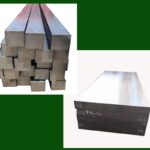Alloy steel and carbon steel, as two prevalent metallic materials, are widely employed in industries such as machinery, construction, chemicals, and healthcare. The superiority or inferiority of their thermal conductivity directly impacts their industrial applications. However, the differences in thermal conductivity between the two are primarily influenced by factors like chemical composition, microstructure, temperature, and processing techniques. This article will provide a comparative analysis of thermal conductivity between alloy steel and carbon steel.

A Comparative Analysis of Thermal Conductivity between Alloy Steel and Carbon Steel:
In terms of chemical composition, the addition of alloying elements like chromium, nickel, and molybdenum in alloy steel typically lowers their thermal conductivity due to these elements’ inherently lower thermal conductivity. Conversely, carbon steel, with a relatively simple composition mainly consisting of carbon and iron, boasts higher thermal conductivity of these elements, resulting in generally better thermal performance compared to alloy steel.
Regarding microstructure, different microscopic structures lead to variations in thermal conductivity. Carbon steel, with fewer alloying elements and a relatively regular crystal structure, experiences less obstruction to heat conduction, thus exhibiting superior thermal conductivity. In contrast, alloy steel, with more alloying elements and compounds, possesses a more complex microstructure that somewhat hinders heat transfer, ultimately resulting in inferior thermal conductivity compared to carbon steel.
Temperature is another crucial factor affecting the thermal conductivity of both alloy steel and carbon steel. As temperature rises, the thermal conductivity of materials generally increases. Under identical temperature conditions, carbon steel typically exhibits a higher thermal conductivity than alloy steel. This is attributed to the denser atomic distribution in carbon steel, which shortens the mean free path of atomic motion, accelerating heat transfer. Conversely, alloy steel’s inclusion of various metallic elements often necessitates heat transfer across longer distances, thereby reducing thermal efficiency.
Processing techniques also play a role in influencing the thermal conductivity of these materials. Techniques like heat treatment and cold working can eliminate structural defects caused by casting, forging, or welding, homogenizing the composition and structure of carbon steel, and reducing obstacles to heat conduction. While processing can somewhat enhance alloy steel’s thermal conductivity, the relatively disordered distribution of various atoms within alloy steel still impedes heat transfer, rendering its thermal conductivity inferior to that of carbon steel.
Conclusion
In conclusion, alloy steel and carbon steel, as two essential alloys, exhibit distinct thermal conductivities influenced by chemical composition, microstructure, temperature, and processing techniques. Given the critical importance of thermal conductivity in enhancing material safety and reliability, it is imperative to consider its impact on performance when selecting materials to ensure steel meets specific engineering requirements.
Why Choose Huaxia Steel?
Thank you for reading our article and we hope this comparative analysis of thermal conductivity between alloy steel and carbon steel can be helpful to you. If you are looking for suppliers and manufacturers of alloy steel and carbon steel, we would advise you to visit Huaxia Steel for more information.
As a leading supplier of alloy steel and carbon steel, Huaxia Steel offers customers high-quality carbon steel, alloy steel, and tool steel at competitive prices.








